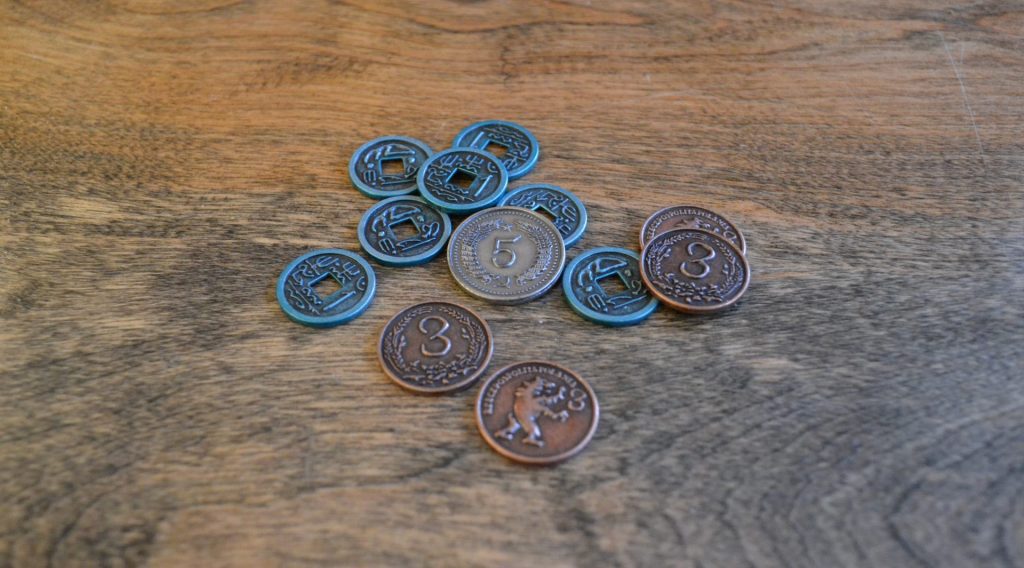What makes you want to pick something up and hold it in your hand? There are a lot of great games out there, but only a few make you want to reach out and grab them. In this Top 6 list of Irresistibly Touchable Games, we cover games that have components that really elevate the experience. And while these components may not be necessary for the gameplay, they definitely make the game better. Whether it’s their weight, texture, or the nice sound it makes when you put the piece down, something about them makes it impossible for players to leave them alone.
Azul
In classic euro-game fashion, the players in Azul are doing a relatively mundane task: tiling a wall. Players will collect Starburst candies plastic tiles, adding them to their player board to complete the tiling pattern. These pieces work perfectly both thematically and mechanically. They’re easy to slide across your board, and tons of fun to knock into the middle of the play area. The tile pieces are so loved in Azul that people who own the first edition of the game have actually gone out of their way to get the new first player marker that was an upgrade from cardboard to the same material as the tiles after the first edition.

These pieces even make game setup and maintenance a fun experience. I always find myself reaching for the bag to restock the tiles in between rounds. From the smoothness of the tiles to the soft clicking sound they make as you mix them in the bag, these pieces are delightful. Just be sure you don’t accidentally mix them into your gaming candy bowl.
Splendor
Splendor is a light strategy engine builder where players are collecting and trading gems to gain points. Like a good set of poker chips, the gems in Splendor just feel “right”. The large, weighted tokens that act as Splendor’s currency are being constantly handled: players spend almost every turn exchanging them with the bank. Games of Splendor are often punctuated with the familiar chk-chk-chk-chk-chk! of a player cascading their stack. What makes this particularly great is that these tokens never had to be fancy: the game could have easily been published with a set of cardboard chits, or little plastic gemstones. But it wasn’t, and that’s… nice. Something about paying for a card with a hefty stack of coins makes the experience all the more worthwhile.
That said, there is a caveat to offer here. Copies of Splendor manufactured after 2016 no longer have the ferrous cores of the original printing. Some sleuths on BGG did a little investigating and found that the production had been scaled back to a slightly more affordable material. The new gems are still nice to handle, but if you want the best experience, an early printing is going to have the best gems.

Gizmos
Gizmos is a medium strategy engine builder where players are inventing different gadgets (or gizmos) using different types of energy. Energy is represented by different coloured marbles, and players get to pick their energy from a fantastic marble dispenser. The energy doesn’t need to be represented by marbles for the game to work, but I’m sure glad it is. Instead of simply having a market of cards to show available energy and randomize player options, Gizmos uses an exciting marble dispenser. Reaching in to draw a random marble is so much fun, and spending energy results in a satisfying clink as you drop them back in with the rest.

If I’m waiting for my turn, you can find me entranced by my energy, swirling them in circles in the ring they are kept in. I try to see how fast I can spin them before the jump out onto the table. Who needs a fidget spinner when you have circle of marbles?
Dimension
Dimension, a real-time stacking puzzle game, is one of the few board games that uses spheres as a board game component. Unlike games that use marbles, the larger plastic spheres in Dimension are actually necessary.

The component’s shape itself is functional; the real-time gameplay pits players in a race to build pyramid-like structures on their player tray following certain rules. The spheres enable players to find unique and clever ways of solving these puzzles. It might be that two colours cannot touch or that a certain colour of sphere must be above the others. Spheres make these challenges possible. The size and weight are also perfect: they are easy to grab and manipulate plus they don’t roll around the gaming table, especially when you are rushing to finish puzzling before the time runs out. The only problem with these pieces is that you might get so occupied playing with them you forget to actually play the game.
Squadro
Squadro is a beautiful two-player abstract game. While any game in Gigamic’s Modern Classics series could be selected, since they use such high quality wooden pieces and boards, I’ve chosen Squadro because it’s my favourite from the set. The first time I took out Squadro’s board I had to re-establish my grip. It’s surprisingly heavy! But more than weight, the board is an act of tailored design.
Squadro’s playing surface is scored with a series of grooves, each slot carved in the perfect outline of its oddly shaped pieces. Since Squadro is played in an unusual arrangement of five-by-five perpendicular lines, Gigamic went the extra mile to craft the board. The resulting grid is easy to read at a glance — and perfect for the playing pieces. The pieces themselves are bevelled, carefully tapering to indicate direction. When you make a move in Squadro, the piece feels smooth and tailored. It’s a testament to Gigamic’s design team that such a simple game can look and feel so nice.

Scythe (Collector’s Edition)
This heavy-strategy resource management game sky-rocketed in popularity after its release in 2016. People who didn’t even play that many board games would ask me if I’d heard of it. This is because Scythe is a beautiful and enthralling game, with or without the upgrades. But when you’re playing with the Collector’s Edition, every piece is so satisfying. The metal coins have become famous in the board game community as the gold standard for coins. They have intricate designs, beautiful colouring and varying sizes, just like a real currency. Not to mention they have some actual heft to them. When a game comes with metal coins it’s always exciting, but it can be a real let down if they’re made cheaply.

The Collector’s Edition also comes with tiny resin pieces to represent each type of resource. These little guys just elevate the game that extra level.
Honourable Mention: Tzolk’in
Tzolk’in is a little different than the other games in the list. While its pieces are perfectly common, the gear mechanism in the middle of the board leads to a different kind of thrill.
In Tzolk’in, five gears surround a larger sixth gear in the middle. Players take turns placing their pieces on the outer gears. Each round, the central gear is rotated one notch, which in turn moves all the other gears forward. Mechanically, this serves as a kind of time-keeper and action upgrading device: the longer your pieces have been on the wheels, the more powerful their actions will be when removed. This was a neat piece of design that feels as innovative today as it did in 2012.
More than that, though, the turning of the gears is a satisfying ritual. Watching the board change as the gears tick forward feels right, and a little bit resonant too. As the central gear moves on, the game moves with it. After a full rotation, the game is over. That kind of at-a-glance readability combined with Tzolk’in’s feel-good gear play is what earns the game its unusual spot on this list.

Closing Thoughts
It feels only natural to turn a game piece over in your hands. They are, after all, designed to be handled. I hope this list serves to honour a few of the games that make this compulsion just a little bit more fun.
Now, if you’ll excuse me, I’ll be building an inukshuk out of my Catan pieces.
This Top Six was a collaborative piece brought to you by “Maple Mountain”, the self-named group of Canadian authors here at Meeple Mountain.











Add Comment